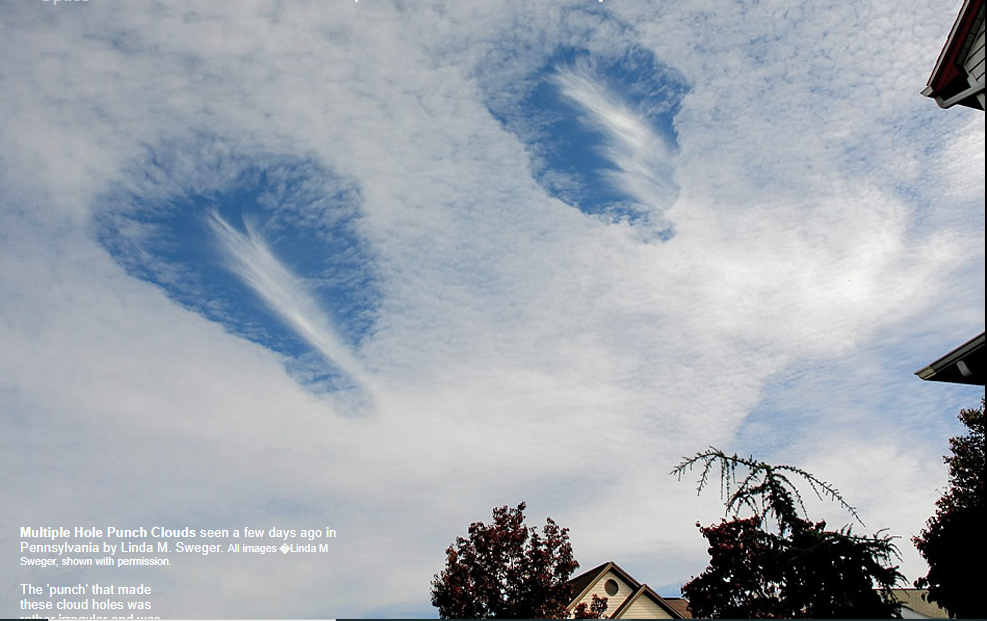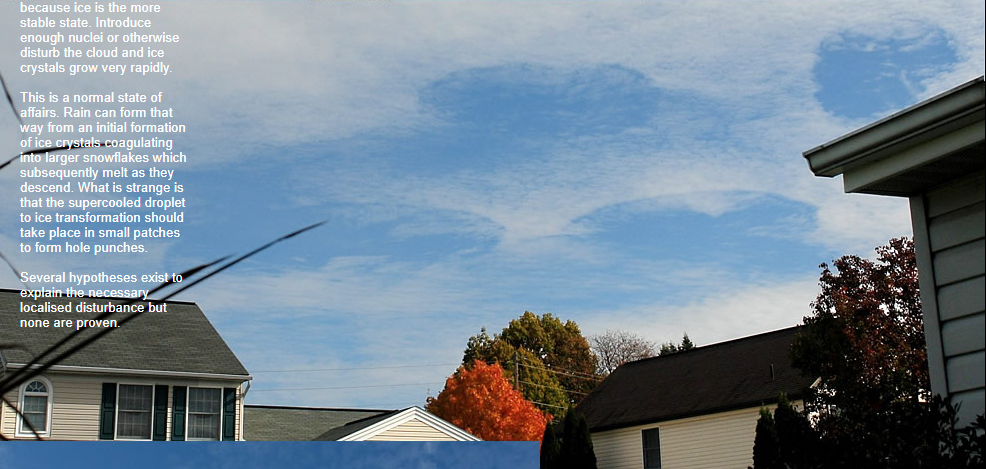Multiple Hole Punch Clouds
Multiple Hole Punch Clouds: A Phenomenon of Atmospheric Optics
Have you ever looked up at the sky and noticed peculiar cloud formations with perfectly round or oval-shaped holes in them? These mesmerizing cloud patterns, known as multiple hole punch clouds, have captivated the attention of sky watchers and photographers alike. In this article, we will delve into the intriguing world of multiple hole punch clouds and explore the scientific explanations behind their formation.
Unveiling the Enigmatic 'Punch'
Multiple hole punch clouds, as the name suggests, are characterized by a series of holes or gaps that appear within an alto-cumulus cloud layer. These cloud formations can be irregular in shape and are often accompanied by ice crystals, known as virga, streaming from the holes. Interestingly, the presence of halos around these ice crystals indicates their substantial size.
Unraveling the Mystery
The formation of hole punches is believed to arise from a meteorological instability that triggers a sudden transformation of supercooled droplets within the altocumulus cloud into large ice crystals. This transformation occurs when the droplets encounter certain conditions, such as the presence of nuclei or seed crystals. These nuclei could originate from ice crystals descending from a higher cirrus cloud, acting as catalysts for the transformation process.
The Marvel of Supercooled Droplets
Supercooled droplets refer to water droplets that remain in a liquid state despite being at sub-zero temperatures. In the absence of nuclei or disturbances, these droplets can cool well below the freezing point without freezing. However, once disturbed or introduced to sufficient nuclei, rapid ice crystal growth occurs. This phenomenon is not uncommon and can even contribute to the formation of rain through the coagulation of ice crystals into larger snowflakes that subsequently melt during descent.
The Puzzling Patchwork of Holes
What sets multiple hole punch clouds apart is the localized transformation of supercooled droplets into ice crystals, resulting in the formation of distinct hole punches within the cloud layer. Although several hypotheses have been proposed to explain this localized disturbance, none have been definitively proven. The scientific community continues to explore various possibilities, striving to unlock the secrets behind this enigmatic atmospheric phenomenon.
Captivating Visual Spectacles
The captivating visual display presented by multiple hole punch clouds has drawn the attention of photographers and sky enthusiasts worldwide. The juxtaposition of the clear blue sky and the intricate patterns of the cloud holes creates a stunning spectacle that is truly awe-inspiring. These clouds can be observed in various locations, and their occurrence is not limited to specific geographical regions or climate conditions.
A Constant Source of Wonder
As we gaze up at the sky, the ever-changing nature of our atmosphere never fails to inspire a sense of wonder. Multiple hole punch clouds serve as a reminder of the complexity and beauty that exists above us. The interplay between temperature, humidity, and ice formation within clouds creates an intricate dance that manifests in these unique cloud formations. Each sighting of a multiple hole punch cloud offers an opportunity to appreciate the intricacies of our natural world.
Conclusion
Multiple hole punch clouds continue to fascinate and intrigue both scientists and laypeople alike. The mysterious transformation of supercooled droplets into ice crystals within localized patches remains a subject of ongoing research. The ethereal beauty of these cloud formations serves as a testament to the remarkable phenomena that occur within our atmosphere. Next time you find yourself gazing at the sky, keep an eye out for these captivating cloud patterns and let yourself be captivated by the wonders of atmospheric optics.

Multiple Hole Punch Clouds seen a few days ago in Pennsylvania by Linda M. Sweger. All images �Linda M Sweger, shown with permission.

The 'punch' that made these cloud holes was rather irregular and was applied many times. The alto- cumulus cloud layer had many holes and more were forming – see the lowermost images.
‘Hole punches’ often have ice crystals, virga, streaming from them. The crystal virga even form halos proving that the crystals are large.
Hole punches are thought to result from an instability that causes supercooled droplets already in the altocumulus to suddenly transform into large ice crystals. The larger ice crystals fall and are in any case are less opaque – we therefore see a hole. A trigger might be other ice crystals tumbling downwards from a higher cirrus cloud that act as nuclei – seed crystals.
Supercooled droplets? Water does not always freeze at 0 degrees Celsius. If no nuclei are present on which ice crystals can grow, the cloud water droplets cool to sub-zero temperatures. But that is a metastable condition because ice is the more stable state. Introduce enough nuclei or otherwise disturb the cloud and ice crystals grow very rapidly.
This is a normal state of affairs. Rain can form that way from an initial formation of ice crystals coagulating into larger snowflakes which subsequently melt as they descend. What is strange is that the supercooled droplet to ice transformation should take place in small patches to form hole punches.
Several hypotheses exist to explain the necessary localised disturbance but none are proven.


Note: this article has been automatically converted from the old site and may not appear as intended. You can find the original article here.
Reference Atmospheric Optics
If you use any of the definitions, information, or data presented on Atmospheric Optics, please copy the link or reference below to properly credit us as the reference source. Thank you!
-
<a href="https://atoptics.co.uk/blog/multiple-hole-punch-clouds/">Multiple Hole Punch Clouds</a>
-
"Multiple Hole Punch Clouds". Atmospheric Optics. Accessed on December 26, 2024. https://atoptics.co.uk/blog/multiple-hole-punch-clouds/.
-
"Multiple Hole Punch Clouds". Atmospheric Optics, https://atoptics.co.uk/blog/multiple-hole-punch-clouds/. Accessed 26 December, 2024
-
Multiple Hole Punch Clouds. Atmospheric Optics. Retrieved from https://atoptics.co.uk/blog/multiple-hole-punch-clouds/.